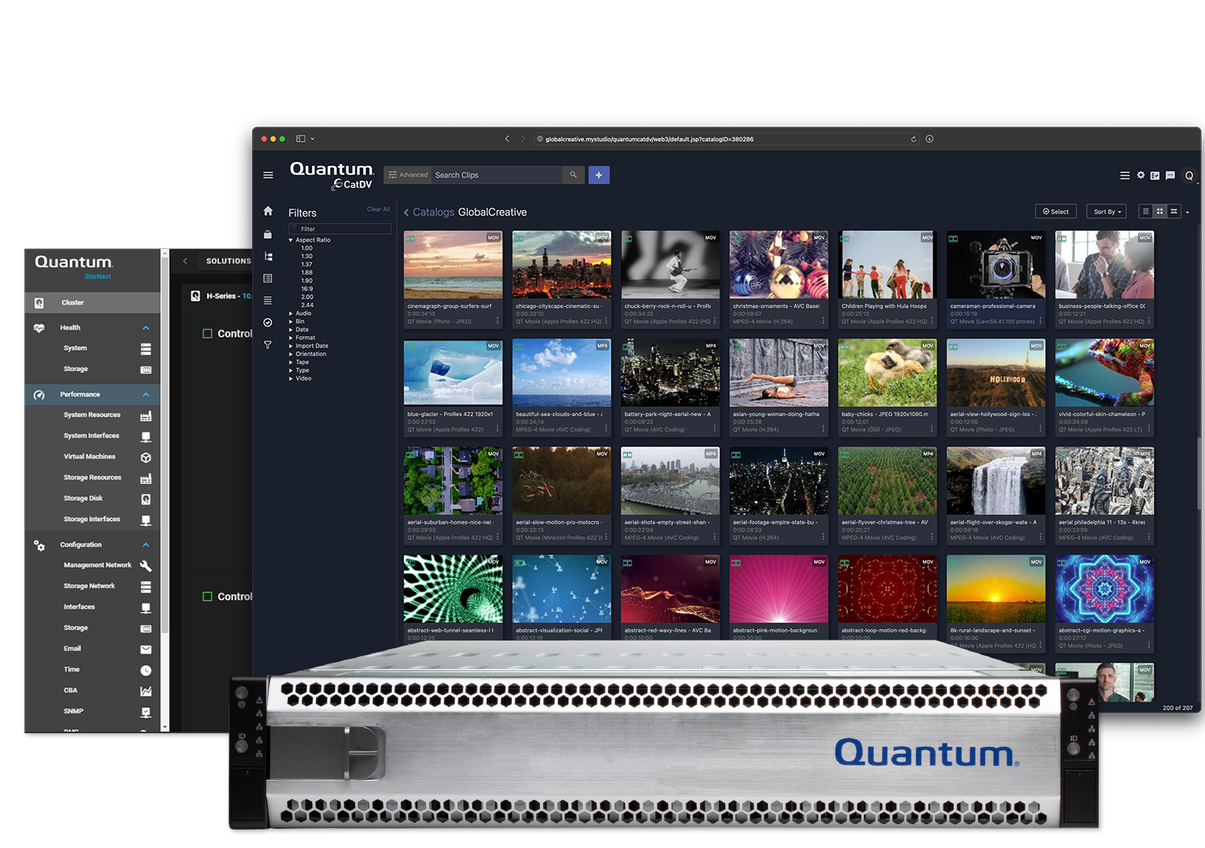Hailing That Storage in the Sky
The evolution of archiving in the cloud

SAN FRANCISCO—It’s a technology that continues to prove its worth and defy its detractors, boasting of speed and touting reliability as a high-capacity storage vault, a means of disaster recovery and a way to share content.
And now, as archiving in the cloud continues to mature, the technology continues to win over large broadcasters and small production houses alike. It has proven to be secure, the capacity to handle massive amounts of data, and support for collaboration between geographic locales separated by continents.
The next steps: Driving long-term value, improving search functions, meeting the needs of different types of customers and addressing thorny issues like cost of egress and long-term adaptability.
Not Just a Simple Migration
“People have become much more comfortable with the reliability, security and affordability of the cloud for content archives,” said Geoff Stedman, chief marketing officer of SDVI. “But what people are also realizing is that simply lifting and shifting an archive to the cloud is not [always] the right approach.”

While the explosion of SVOD, AVOD and FAST channels offers new opportunities to monetize content, that scenario only works if the content can be found, accessed and transported through a media supply chain and then prepared for a distribution partner, Stedman said. “[Migration to a cloud archive] presents an opportunity to standardize and normalize content file formats, clean up and enrich metadata and create an archive of golden masters that can be monetized across many different distribution outlets.”
In addition, it’s not just important how you migrate your content into the cloud, but rather if you have visibility into cloud—and the ability easily retrieve it.
“An organization’s cloud environment can be a bit nebulous,” said Brett Beers, vice president of technology for TMT Insights, a professional services and software development company. “I predict there will need to be more of a focus on investing in productivity and operational tools that will widen the net in terms of the user type that can both interact and manage cloud technology.”
The professional video industry's #1 source for news, trends and product and tech information. Sign up below.
Plus, customers moving their archives to the cloud are not just looking to migrate a tape library; they are looking to derive more long-term value from their assets by applying meaningful metadata during the ingest process, said Evan Statton, senior principal architect of M&E for Amazon Web Services.

“When cloud archiving first came on the scene, simply moving massive amounts of content to and across clouds was the clear challenge,” said Jon Finegold, chief marketing officer for Signiant. “The tools provided by those early cloud systems simply weren’t cut out for massive media archives.”
Today’s software can now effectively move petabytes of content into and out of cloud platforms like AWS, Google Cloud Platform (GCP), Microsoft Azure and Wasabi.
Migration Trends
Across the content creation marketplace, there is new, significant interest for companies of varying sizes to consider migration to the cloud. For some, a lift-and-shift approach might be the right step, particularly for an organization new to the technology. For others, designing a digital supply chain from scratch is a more valuable approach.
“Regardless of the path you pick, the first step is visibility,” said Beers. “What do you have, and then the next step is action: what am I going to do with it?”
TMT Insights faced such a scenario when working with a post house in Burbank, Calif., that was moving from a fully on-premise operation to a 100% cloud-native digital supply chain. “For this engagement, they were able to decrease the time to market and enable rapid innovation by not having the challenges that come with having reliance or integration [with] their legacy systems,” Beers said.
The next challenge: How to help customers easily find and access content archived in the cloud. Several companies, including Signiant, have solutions that automatically index assets and create preview files so customers can perform simple searches across their archives—whether those be on-prem or cloud—without having to move the assets. “Archives need to be actionable,” Finegold said about the company’s Media Engine software. “Accessing them must be quick, easy and cost-effective. When asked for a clip, users need to be able to search, preview and send those assets anywhere, fast.”
Archives need to be actionable, Accessing them must be quick, easy and cost-effective."
Jon Finegold, Signiant
TMT Insights also sees increased demand for this type of functionality. The company’s Polaris operational management platform allows users to manage their end-to-end cloud-based media supply chains via a file manager module within Polaris. That module enables enhanced visibility and gives users controls to manage their ingest and prequalification workflows. By providing users access to the cloud in a purposeful way, one of TMT Insight’s clients was able to increase their on-time delivery from an average of 65 percent to 99 percent, Beers said.
Mining Your Value
Another key trend in the cloud movement: Ensuring customers derive additional long-term value from their assets by applying meaningful metadata during ingest. AWS helped Formula One (F1) achieve this using the AWS Media2Cloud solution when it migrated more than 4 petabytes of archived video content to Amazon S3 and now uses artificial intelligence/machine learning services to reduce the time it takes to catalog content.
“Additionally, we’ve learned from our customers that ‘one size does not fit all’ for archive retrieval patterns,” Statton said, referring to the Amazon S3 Glacier Instant Retrieval storage class and Flexible Retrieval storage class, which are designed to help customers fine-tune retrieval performance based on the needs of archive usage.
The cloud is proving attractive to organizations of all sizes. Giving small creative groups the ability to easily access the cloud was the impetus behind a new release from Quantum that integrates a media asset management module and shared storage software. The goal was to remove the complexity that can often hamper a smaller creative group when it comes to configuring separate devices and setting up separate production workflows.
Quantum’s H4000 Essential provides a standard set of features—automatic context indexing, shared storage—but doesn’t require specialized IT skills to support. That was the case for the creative agency Switch, which works on multiple projects simultaneously via the StorNext collaborative shared storage system and the Quantum cloud-based analytics software.
The benefit: A small creative company can quickly deploy production-ready shared storage in the cloud, allowing for collaborative, remote video editing in the cloud.
SDVI is seeing this as well, as companies of all sizes realize they can become more efficient and agile when they take advantage of cloud technologies, Stedman said. “Moving their archives and media processing to the cloud, even at a relatively smaller scale, frees them up to focus on their core creative business because they no longer have to spend time procuring, deploying and managing on-premise infrastructure.”
AWS is seeing demand from all types of customers, from TV stations to larger broadcasters looking to migrate hundreds of linear channels to AWS. The company was recently awarded an Engineering Excellence Award from the Hollywood Professional Association (HPA) for its “Color in the Cloud” cloud-based remote service that enables customers of all sizes to perform high-fidelity color grading in
the cloud.
Egress Costs
Challenges remain, however. While the cloud has proven its mettle at handling shared content with speed and reliability, there are instances where a cloud gateway linked to a high-capacity storage infrastructure may be a better fit. As veteran media and entertainment tech companies have long known, storage on LTO data tape can be lower in cost per terabyte than primary disk storage.
And in some instances, the best archiving solution is a combination of the old and the new. Software from companies like XenData can be used to create a hybrid archive that links together on-premise storage with the cloud so that file-based applications can write to and read from cloud storage. Using a XenData S3 Server interface with a XenData LTO archive creates a private cloud storage solution allows an organization to keep the attractive aspects of LTO storage onsite. In this scenario, files can be remotely downloaded free of any egress charges.
And that’s another lingering issue for archiving in the cloud to address: The cost
of egress.
Though the industry is moving in that direction, workflows requiring heavy visual effects and editing work are still not fully realized within the cloud to run at scale. So files sometimes must be pulled down and worked on outside of the cloud, with a heavy price tag to boot.
Understanding those types of cloud economics continues to be a key challenge for customers when it comes to archiving in the cloud. “Customers are capturing so much more content and want to preserve all of it,” Finegold said. “But for how long? How much content will be retrieved? When will it impact things like egress costs? These and other questions make predicting costs a real challenge.”
Others say the cost of egress is generally not an issue for content companies moving their archives to the cloud since content deals can be struck between content owners and cloud-based streaming services that are fulfilled without content ever leaving the cloud—with a majority of local, on-premise editing accomplished using proxy files that are a fraction the size of the original master in the cloud.
The most important priorities in an archiving system will be familiar to anyone navigating the modern content creation space: Agility. Adaptability. Visibility. Ideally, as Beers from TMT Insights put it, “Our goal is to make the shift to the cloud less intimidating, to show clients the way and give them the tools they need to navigate that path themselves.”
Susan Ashworth is the former editor of TV Technology. In addition to her work covering the broadcast television industry, she has served as editor of two housing finance magazines and written about topics as varied as education, radio, chess, music and sports. Outside of her life as a writer, she recently served as president of a local nonprofit organization supporting girls in baseball.


